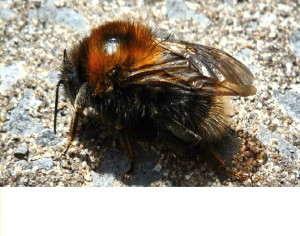IS IT A SWARM OF HONEYBEES ?
First identify the insects. Here are brief descriptions of what you may have.
HONEY BEES


Vary in colour from golden brown to almost black. The Queen the mother of the colony, normally only one present. When mated she will lay all the eggs. If she fertilises an egg they become workers (female) up to 50 thousand at the height of the season, able to sting. If not fertilized they become drones (male)which do not sting about 400 present.

When the colony expands in the spring the natural process to continue the species is a process called swarming. The old queen will lay fertilized eggs in specially prepared queen cells these eggs are fed on a special diet of high protein food called royal jelly which converts the larvae into queens. When the first cell is capped over in preparation for metamorphosis. The old queen will leave with about half the flying foraging bees to start a new colony. The bees may fly a short distance and congregate in a cluster. This is a swarm.

Sometimes they fly further and can land in the most unusual places. Scout bees will then search out a suitable place to continue the activity of the colony.

Bees build their comb from wax produced from glands in their abdomen.
If a swarm enters a chimney it can often be made to relocate by sending smoke up the chimney. Providing it can be done soon enough. If it clusters on the outside of a chimney try spraying with water from a hosepipe.
Honeybees are kept by beekeepers who collect their surplus honey. Honey is produced from nectar collected from many different species of flowers and trees. The bees mix the nectar with enzymes to produce honey. All bees are vital to the pollination of plants, flowers and many crops that we eat, so try to preserve them if possible.
BUMBLE BEES


Rounder and larger than honeybees with a furry covering. Many different colours according to species. Often found in bird boxes under decking in compost heaps, they love an old mouse nest in the ground. Very timid and will not sting unless provoked. Leave them if you can as they are very useful pollinators in the environment. they will also disappear in the autumn after rearing queens which overwinter in the ground or dry places.
There are also species of cuckoo bumblebees that lay their eggs in other bumble bee nests and allow them to rear their young as if they were related to the parent colony.
WASPS
Bright yellow with black stripes. Very smooth and shiny. They build nests of paper mache, in the ground in roof spaces even in bird boxes. They are carnivorous feeding their larvae on aphids and caterpillars, They are useful as pollinators as well. Can be a nuisance later in Summer when they start to eat fallen fruit. Will disappear after the first frosts after they have reared queens which overwinter in dry warm places.



If you have to remove a wasps nest purchase a proprietary wasp spray or powder and spray into the nest entrance late in the evening. When most flying insects will be in the nest. Dress up to avoid stings. Gloves and a net over your face if possible. Do not use a torch as they may fly towards the bright light. You may have to treat more than once. Councils do not run pest control services due to cutbacks and private pest control companies are expensive.
SOLITARY WASPS AND BEES


Over 200 species of solitary bees alone. Most are too weak to sting. Examples are mining bees, mortar bees and rose cutting bees. Great little pollinators. Look after them.
HORNETS


These are the wasps big cousins more black and brown with a hint of orange. Much bigger nests than wasps, but still made from paper mache. Tend to be more timid than wasps but will sting if provoked. To remove follow the same steps as above.
TREE BUMBLE BEES ON THE INCREASE Judging by the number of calls from members of the public with bees taking over bird nest boxes. I can only assume that the Tree Bumble Bee, Bombus hypnorum is doing very well this year. I have been advising the enquirers to leave them alone if possible as they are great pollinators and if LEFT UNDISTURBED will do no harm as they are not aggressive. However they can sting if provoked.
Photo Brian Jones 2013

